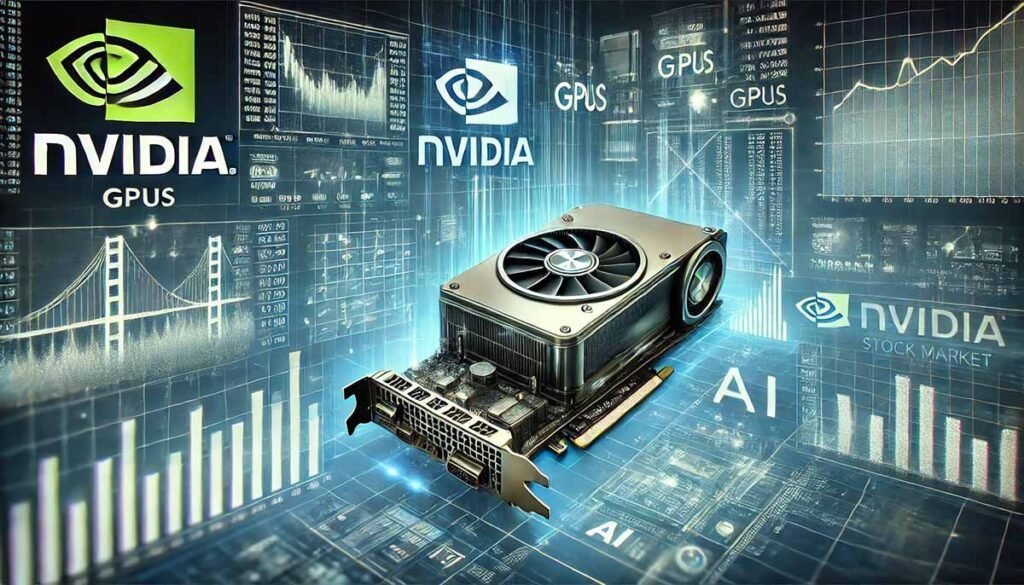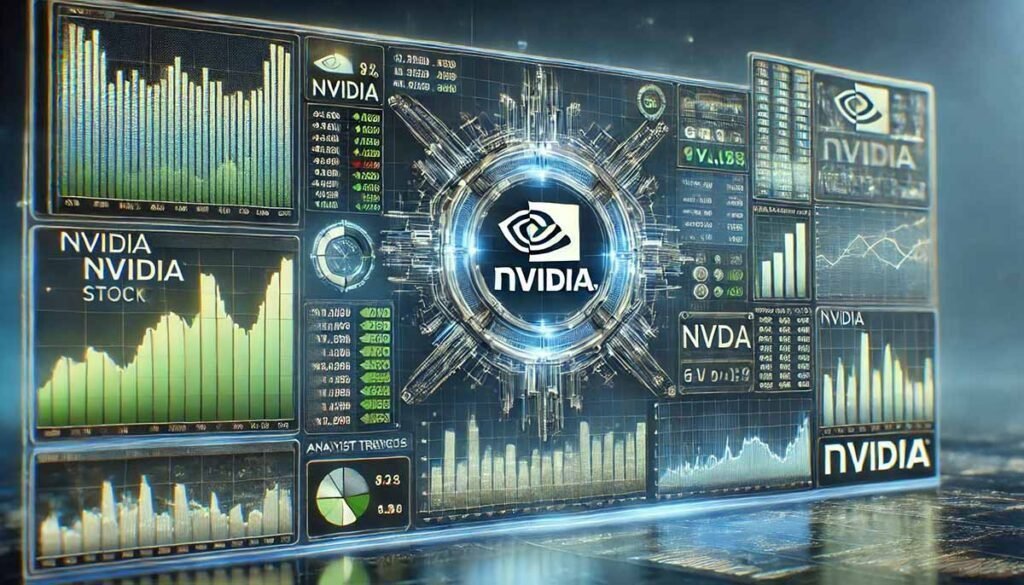NVIDIA stands out as a significant player in today’s fast-paced tech industry. Known for its advanced GPUs (graphics processing units), NVIDIA has also become a key force in artificial intelligence. As tech firms and sectors worldwide push to integrate AI, NVIDIA’s stock has grown significantly, capturing widespread interest.
With the rapid surge in NVDA’s value, many investors are wondering: Is this the ideal time to invest? Here on FintechZoom, we’re examining NVIDIA’s current stock trends and the factors fueling its rise. We’ll look at recent updates, analyst insights, and possible risks worth noting.
For those considering investing, seeing the broader view of FintechZoom NVDA Stock is crucial. NVIDIA’s unique role in tech and AI has brought immense value but also some uncertainties. There’s a lot to consider with new products, strong demand for AI chips, and a changing market environment.
This breakdown will offer a clearer perspective on NVIDIA’s recent momentum and help address the question: Is now the right moment to invest in NVDA? Let’s dive in!
- Understanding NVIDIA's Market Position and Recent Developments
- Recent Performance of NVDA Stock
- Financial Highlights and Analyst Forecasts
- Key Factors Impacting NVIDIA Stock Performance
- Pros and Cons of Investing in NVDA Stock Right Now
- Tips for Investors Considering NVDA Stock
- Conclusion: Is Now the Perfect Time to Buy?
- FAQ Section
Understanding NVIDIA’s Market Position and Recent Developments


NVIDIA’s Market Leadership
NVIDIA stands out as a major technology force thanks to its groundbreaking graphics processing units (GPUs) and prominent role in artificial intelligence (AI). Initially known for creating high-powered GPUs essential for gaming, these tools have evolved to become critical assets in data centers, machine learning, and deep learning. Today, NVIDIA’s GPUs support AI in diverse healthcare, automotive, and finance sectors.
NVIDIA’s AI processors are now essential for cloud computing and advanced analytics, establishing the company as a top innovator in AI. This status has propelled its stock to record levels over the past year. Investors view NVIDIA as a tech company and a leader in AI technology, driving strong market confidence.
Key Developments and Market Moves
1. New Blackwell AI Processors
NVIDIA recently introduced its upcoming Blackwell AI processors, which are expected to launch soon. These chips have already generated significant interest; they’re reportedly fully pre-sold for the next 12 months, reflecting intense demand. This development further appeals to NVDA stock, as these processors aim to deliver even greater efficiency and performance for AI uses.
2. High Demand Amid AI Boom
The surge in AI has sharply increased NVIDIA’s sales. As more organizations adopt AI, they require the high-performance processors that NVIDIA provides. This demand has tripled NVIDIA’s valuation over the past year, elevating it among the most valuable companies globally.
3. Potential Headwinds
Despite its achievements, NVIDIA faces some challenges. Recent market shifts have raised concerns, particularly within the broader tech sector. For instance, Microsoft’s recent forecast missed expectations, drawing attention to possible slowdowns in AI spending. This trend might affect NVIDIA’s sales indirectly if major tech clients start limiting AI infrastructure investments.
The Bigger Picture
NVIDIA’s advances in AI are transforming the industry, setting a high bar for others. Its position in this market is unrivaled, making it a cornerstone in tech. However, changes in market trends and customer spending warrant attention. For those tracking FintechZoom NVDA Stock updates, staying informed on NVIDIA’s latest moves can provide valuable insight into the future of this tech leader.
Recent Performance of NVDA Stock
Stock Price Trends
NVIDIA’s stock has experienced notable fluctuations in recent months, mirroring fast-paced shifts in the tech and AI sectors. After a strong upward trend, NVIDIA’s stock recently dropped 4.72% from previous highs. As of November 1, 2024, the price stands around $132.76 per share. Despite this dip, the overall growth over the past year remains substantial.
To illustrate the trend, here’s an overview of NVIDIA’s stock performance over the last year:
- Early growth: In early 2023, NVIDIA’s stock steadily increased as interest in AI technology surged.
- Mid-2024 peak: By mid-2024, the stock had nearly tripled in value compared to the prior year, fueled by demand for AI-driven chips.
- Recent decline: Over the past month, a slight decrease occurred, primarily due to broader tech sector volatility.
Year-over-Year Growth
Despite recent declines, NVIDIA’s stock has displayed strong growth. Over the past year, NVDA has nearly tripled in value, largely driven by the global adoption of AI technology and the demand for NVIDIA’s products. Analysts highlight that this annual growth ranks NVIDIA among the top-performing tech stocks.
To provide context on this growth:
- Annual Revenue Increase: NVIDIA reported a considerable rise in annual revenue, primarily due to sales of GPUs and AI processors.
- Market Capitalization Growth: NVIDIA’s market cap now stands at approximately $3.42 trillion, placing it among the world’s most valuable companies.
Market Response to Key Announcements
NVIDIA’s stock price has shown sharp reactions to product launches and new partnerships. For instance, announcing its upcoming Blackwell AI processors, already sold out for the next year, generated positive investor sentiment. These processors offer improved performance, boosting demand from cloud providers and tech companies.
However, the stock also faced pressure after Microsoft’s recent earnings report, which suggested a possible deceleration in AI infrastructure spending. This news impacted large tech stocks, including NVDA.
Visual Overview of NVIDIA’s Stock Performance
Below is a visual representation of NVIDIA’s stock performance over the past year. The chart displays major peaks and dips, marking key events like the Blackwell AI processor announcement and recent tech sector volatility.


Financial Highlights and Analyst Forecasts


Recent Financials
NVIDIA’s latest financial performance reinforces its strong standing in the tech sector. The company’s market cap currently hovers around $3.42 trillion, placing it among the most valuable companies globally. Much of this rise is due to NVIDIA’s expanding footprint in AI. Its revenue streams from AI and data center solutions are increasing rapidly, boosting both revenue and profit growth.
Key financial highlights include:
- Revenue Increase: NVIDIA reported record-high revenues, driven primarily by surging demand for its high-performance GPUs and AI-specific processors.
- Profit Margins: Despite significant costs related to research and development and product advancements, NVIDIA has maintained favorable profit margins, indicating effective management and high product demand.
- Cash Reserves: With strong cash flows, NVIDIA has the liquidity necessary to invest extensively in R&D, helping it stay competitive in the fast-paced AI and tech sectors.
These financial strengths place NVIDIA in a solid position to leverage AI trends, even amid market fluctuations.
Analyst Projections
Analysts are optimistic about NVIDIA’s trajectory, with many setting price targets above the current stock level. The consensus price target is $145.84, implying that analysts expect further gains. This outlook reflects NVIDIA’s leadership in AI technology and its steady ability to meet the increasing needs of companies integrating AI into their operations.
Additional insights from analyst forecasts:
- Growth Outlook: Analysts predict continued revenue growth as the demand for AI processors stays high.
- Tech Sector Leadership: NVIDIA’s leadership in AI and GPUs makes it a top recommendation among tech stocks.
- Potential Risks: Some analysts note that market volatility and changes in tech spending could affect growth in the short term.
In summary, analysts see NVIDIA’s financial strengths and strategic advantages as solid investment factors. However, they suggest investors monitor market trends that might impact its future performance.
Key Factors Impacting NVIDIA Stock Performance
The AI Investment Boom
One of the primary drivers of NVIDIA’s stock performance is the surge in AI investments. Companies worldwide are racing to incorporate AI, and NVIDIA’s AI chips play a crucial role in this trend. These GPUs power applications ranging from deep learning algorithms to massive data centers, making NVIDIA a vital player in AI development.
Industries such as healthcare, automotive, and finance are increasingly dependent on AI, using it for tasks like diagnostics and autonomous driving. This widespread adoption fuels demand for NVIDIA’s GPUs and AI processors, boosting revenue and stock value. The AI boom has created a unique growth opportunity for NVIDIA, which remains a core focus for investors watching FintechZoom NVDA Stock.
External Market Influences
However, NVIDIA is not isolated from broader market trends. For example, Microsoft’s recent earnings report suggested a possible slowdown in tech spending, particularly on AI infrastructure. This announcement caused concerns across the tech sector, including NVIDIA, as reducing tech giants’ spending might impact AI chip sales.
Global economic factors like inflation, interest rates, and geopolitical tensions have also created stock market uncertainty, increasing volatility for stocks like NVIDIA. Investors should monitor these external factors closely, as they could affect NVIDIA’s sales growth and, in turn, stock performance.
Supply Constraints and Demand
Intense demand for NVIDIA’s products is another crucial factor impacting its stock, sometimes outpacing supply. For example, the upcoming Blackwell AI processors are already fully reserved for the following year. While high demand is generally a positive sign, supply constraints could limit NVIDIA’s ability to fulfill orders promptly, potentially slowing revenue growth.
If NVIDIA can scale production to meet this demand, the company’s revenue could see substantial gains. However, challenges in production and potential supply chain bottlenecks remain, especially in a high-demand environment. For those tracking FintechZoom NVDA Stock, observing NVIDIA’s capacity to meet demand is essential for predicting future stock performance.
The Bigger Picture
NVIDIA’s stock performance reflects a blend of internal strengths and external challenges. The rapid growth of the AI market, combined with the high demand for NVIDIA’s advanced processors, offers significant growth opportunities. However, economic uncertainties, tech spending shifts, and supply constraints add complexity to NVIDIA’s growth outlook. For investors in FintechZoom NVDA Stock, understanding these factors provides valuable insight into NVIDIA’s market position and the future.
Pros and Cons of Investing in NVDA Stock Right Now
Pros of Investing in NVDA Stock
Market Leadership in AI
NVIDIA leads decisively in AI and GPU technology. Its processors are essential for AI applications, giving it a notable advantage over rivals. As many industries incorporate AI, NVIDIA stands poised for sustained growth.
High Demand and Revenue Growth
Demand for NVIDIA’s GPUs has surged. New products like the Blackwell AI processors are sold out for the next year, pointing to strong future revenue. For investors, this suggests solid short- and long-term growth potential.
Strong Financial Health
NVIDIA’s recent financial reports show solid profit margins and significant cash reserves. This financial foundation allows NVIDIA to invest in R&D and keep its technological lead. These factors strengthen investor confidence, making NVDA stock appealing for growth-focused portfolios.
Cons of Investing in NVDA Stock
Market Volatility
The tech sector often experiences price swings, and NVIDIA is no exception. Recent concerns about potential decreases in AI spending and broader economic challenges have caused fluctuations in its stock price. Investors should expect possible short-term variations.
Dependence on AI Demand
NVIDIA’s growth closely relies on the demand for AI technology. NVIDIA’s growth could be affected if AI adoption slows or shifts unexpectedly. Additionally, NVIDIA may face stiffer competition if rivals enter the AI chip market more aggressively.
Supply Chain Challenges
High demand is promising, but supply constraints could slow NVIDIA’s ability to fulfill orders quickly. These delays might impact revenue growth if NVIDIA cannot meet demand in a timely manner.
Final Thoughts
Investing in NVDA has substantial potential but carries certain risks. For those tracking NVDA Stock through FintechZoom, weighing these pros and cons can help them make an informed investment choice.
Tips for Investors Considering NVDA Stock
1. Think Long-Term
NVIDIA’s strengths in artificial intelligence and technology innovation make it a promising option for those with a long-term investment outlook. If you decide to buy NVDA, consider holding it for several years. This strategy helps you manage short-term market changes while benefiting from NVIDIA’s potential growth as advancements in AI continue.
2. Diversify Your Portfolio
Although NVIDIA performs strongly, tech stocks often experience high volatility. Including investments in other sectors helps spread risk. A diversified portfolio can add stability, helping to balance your NVDA investment through various market fluctuations.
3. Monitor Market Trends
Stay informed on trends in technology and AI. Track significant announcements from NVIDIA, especially regarding new products or industry developments. Platforms like FintechZoom offer timely updates on NVDA stock, helping you stay alert to factors that might affect its value.
4. Set a Risk Threshold
Establishing a risk limit is helpful for any stock, particularly in high-volatility sectors. Determine in advance how much risk you’re comfortable with and at what point you might adjust your position. This approach aligns your investment with your financial goals and prevents reactive decisions due to sudden market shifts.
These tips can help you make a well-informed decision, balancing NVIDIA’s growth potential with a careful investment strategy.
Conclusion: Is Now the Perfect Time to Buy?
NVIDIA remains a powerful force in technology, leading advancements in AI and GPU markets. For those monitoring FintechZoom NVDA Stock, the increasing demand for AI processors and NVIDIA’s solid financials make it an appealing option. However, the choice to invest in NVDA involves careful consideration.
Though NVIDIA’s growth potential is substantial, there are risks, including tech sector volatility and reliance on AI-driven demand. For investors with a high risk tolerance and a long-term perspective, NVIDIA could prove to be a valuable addition. More cautious investors may prefer to wait for stronger indications of market stability.
Ultimately, NVIDIA presents significant opportunities, but assessing potential gains and associated risks is crucial. The timing could be favorable for some, yet each investor should align their decision with personal strategy and financial goals before proceeding.
FAQ Section
1. What is FintechZoom NVDA Stock, and why is it popular?
FintechZoom NVDA Stock refers to NVIDIA Corporation’s stock, which is tracked and analyzed on FintechZoom. It attracts attention because of NVIDIA’s strong role in AI technology and GPUs, making it a prime choice for tech-focused investors.
2. Is NVIDIA a good long-term investment?
Many analysts consider NVIDIA a promising long-term investment due to its lead in AI and steady innovation. However, assessing potential market shifts and competition is also important.
3. What are the main risks of investing in NVIDIA stock?
Key risks include:
- Volatility in the tech sector.
- Possible fluctuations in AI demand.
- NVIDIA’s reliance on stable supply chains to meet demand.
4. Why has NVIDIA stock been so volatile recently?
NVIDIA’s stock responds to tech sector trends and shifts in investor sentiment around AI. Recent volatility reflects broader economic factors and changing expectations for tech investment.
5. Should I buy NVIDIA stock now or wait?
The choice depends on your investment strategy and comfort with risk. NVIDIA shows growth potential, but if you prefer caution, waiting for a more stable market or a favorable price may be a sound approach.
If you found our content helpful don’t forget to share it on your social media: Twitter.
For more insightful articles related to business, please visit Bloghart.


